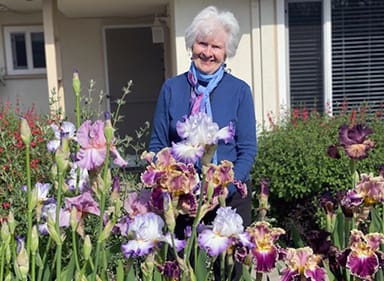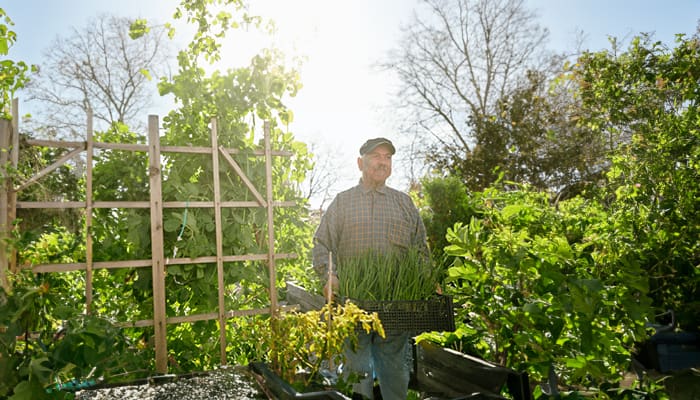August 31, 2023
Plant, Grow, Love
Claremont Manor resident inherits passion for irises from two generations.
It’s mid-summer and the landscape surrounding Eleanor Foerster’s cottage at Claremont Manor is mostly solid green, with just a few dots of white, yellow and red blooms from her rose bushes. But just wait until spring.
For almost a decade around April, there’s been a block of endless color around Eleanor’s Claremont home. Purples bumped up next to oranges, lavender-gold next to a steely blue. The Irises have bloomed!
Eleanor’s love of irises began in the 1960s while living in Porterville, in Tulare County, California. “My mother and grandmother adored irises,” Eleanor said. “My parents were teachers but also farmers. We had chickens, cows, horses and of course irises.”

Her mother Marguerite’s passion blossomed into a collection of dozens of varieties of the flowering plant. Eleanor’s parents befriended cross-town neighbors Jim and Edna Gibson. Jim was a teacher but also an Iris hybridizer who crossed different varieties of the plant to create new colors. He shared Marguerite’s enthusiasm for the colorful plant.
“He outlived both my parents and became somewhat of a mentor to me with regard to irises,” Eleanor said. “He taught me and my husband everything about them.”
In 1982 Marguerite passed away but not before insisting to Eleanor that she take her irises. “She said they are your inheritance. Take them everywhere you go.” She did so and when she and her husband, who she calls “my partner in gardening” before his death last year, moved to Claremont Manor in 2015 she brought more than 50 irises with her. “I was not going to move somewhere where there was no dirt,” Eleanor said with a laugh. “I was fortunate to find exactly what I was looking for at Claremont Manor.”
Eleanor moved to a one-bedroom cottage on the east end of the campus. The home had recently been remodeled so the landscape was a blank slate. “I told the landscapers that I would take care of the plants because I knew exactly what I wanted to do.”
Her front, side and back yards are filled with enough irises to make any gardener proud. Row upon row surround walkways by slim barriers of stepping stones and edging. The perennial plants are the result of countless hours of digging, composting, fertilizing, staking, labeling, weeding and clearing. She currently raises 42 different Tall Bearded irises in various colors.

“Irises are just beautiful,” Eleanor said. “Looking at an iris is like looking at a piece of lace. They have a special place on earth.”
From a humble beginning of just a few plants on her parent’s farm, Eleanor says the passion has taken over. While there are other trees, plants and flowers in her garden — king palms, roses, salvia and gerbera daisies, among others, It’s the irises for which Eleanor is most known.
Irises come in four original colors called flags – blue, yellow, bluish-purple and white. All other colors are the result of hybridization, which causes more blooms and heartier plants. For years, Eleanor said, growers have tried to create a red bloom through hybridization but have not yet been successful, although coming close with a pink flower.
Iris flower history dates back to Ancient Greece and drawings are still visible in a number of ancient palaces. According to Greek mythology, Iris was the messenger of the gods, a connection between heaven and mortal human beings on earth. Iris was the goddess of the rainbow and beautiful flowers sprouted wherever she stepped.
Walking her garden, Eleanor can unfailingly recite the whimsical names of her plants, (given by the grower-hybridizer), including “Achy-breaky Heart,” “Going My Way,” “Drama Queen,” “Gypsy Lord” and “Bottle Rocket,” among dozens more. She keeps a detailed hand-written log (for her own enjoyment) as to when each flower blooms (or doesn’t bloom) each spring. “It’s hit and miss,” she said, pointing to several plants that did not bloom this year. Irises are draught tolerant so the worst thing a grower can do is over water, “The roots can rot and destroy the plant’s rhizome (rootstock) with too much water,” Eleanor said with conviction.
Eleanor’s knowledge of Irises is so vast that she recently prepared a detailed audio-visual presentation to share with fellow residents. She hopes one or more of her 6 grandchildren and 14 great grandchildren will embrace their inheritance and carry on the tradition of raising irises.
“My mother said it best,” Eleanor said. “Each Iris speaks to you. Once you get to know them you know exactly how to take care of them.”






